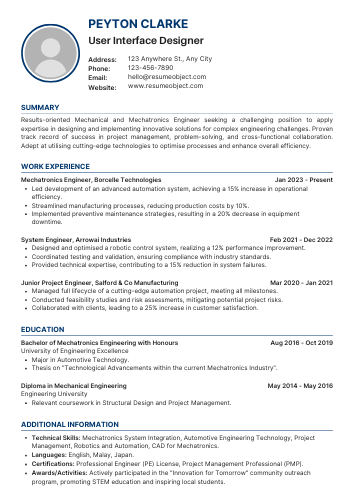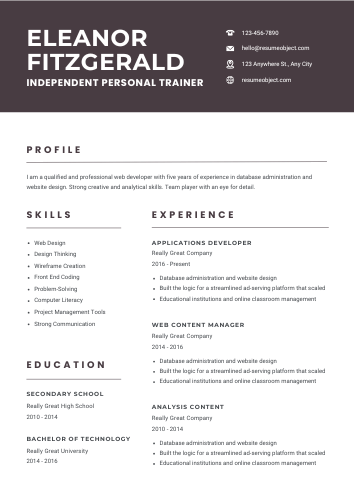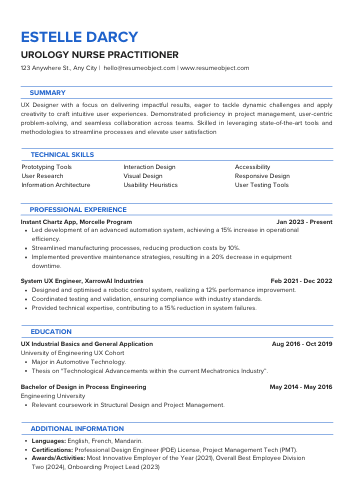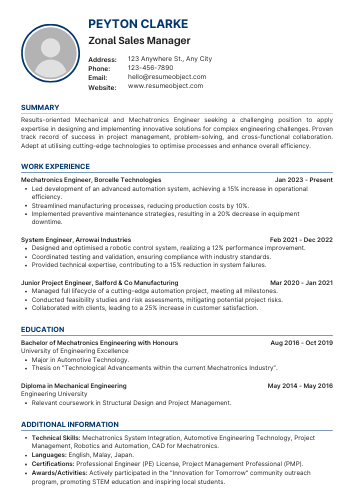EMT-B Job Description for Resume in 2025 – Key Duties, Responsibilities, Action Verbs
EMT-B Job Description for Resume
The EMT-B job description for a resume is crucial for showcasing your skills and responsibilities in this vital role. As an Emergency Medical Technician-Basic, you are often the first responder in critical situations, providing essential care and support to patients in distress. Highlighting your expertise in emergency response, patient assessment, and life-saving techniques can set you apart in a competitive job market.
In this article, we will outline the key duties and responsibilities associated with the EMT-B role, along with powerful action verbs that can enhance your resume. By effectively presenting your qualifications, you can demonstrate your readiness to make a difference in emergency medical services.
EMT-B Job Description for Resume
EMT-B, or Emergency Medical Technician-Basic, is a vital role in the emergency medical services (EMS) sector, primarily responsible for providing immediate medical care to patients in emergency situations. EMT-Bs are trained to assess patients, perform basic life support, administer oxygen, and manage trauma and medical emergencies. Their primary purpose is to stabilize patients and ensure safe transport to medical facilities, making them crucial first responders in emergencies.
In the healthcare industry, EMT-Bs serve as the frontline of emergency medical care, often working in high-pressure environments such as ambulances, hospitals, and disaster sites. This entry-level position offers a pathway into the medical field, with opportunities for advancement to higher certifications and roles. EMT-Bs typically work in dynamic settings, collaborating with paramedics, firefighters, and other healthcare professionals to deliver critical care and support during emergencies.
How a EMT-B Job Description Enhances Resume
A strong job description is crucial for an EMT-B resume as it serves multiple purposes that enhance the candidate's appeal to recruiters and hiring managers. Here's why this section grabs attention and its significance in the hiring process:
-
Recruiter Attention: A well-crafted job description highlights specific skills and experiences relevant to the EMT-B role, making it easier for recruiters to identify qualified candidates quickly.
-
ATS Keyword Matching: Many employers use Applicant Tracking Systems (ATS) to filter resumes. Incorporating relevant keywords related to EMT-B responsibilities ensures that the resume passes through these systems, increasing visibility.
-
Demonstrating Achievements: A strong job description allows candidates to showcase their accomplishments, such as successful patient outcomes or efficient emergency response times, which can set them apart from others.
-
Relevance: Tailoring the job description to reflect the specific requirements of the EMT-B position demonstrates a clear understanding of the role and its demands.
-
Measurable Impact: Including quantifiable results, like the number of successful interventions, provides concrete evidence of the candidate's capabilities, making the EMT-B resume more compelling.
In summary, a strong job description is vital for an EMT-B resume, as it captures attention, aligns with ATS requirements, and effectively showcases achievements and relevance.
Learn more about optimizing your resume by visiting our full guide on Server Job Description for Resume.
EMT-B Job Description Examples
Entry Level Resume Job Description Examples
-
Emergency Medical Technician (EMT-B): Provide immediate medical care and transport patients to medical facilities. Assess patient conditions, administer basic life support, and communicate effectively with healthcare professionals.
-
Ambulance Attendant: Assist in the transportation of patients to and from medical facilities. Support EMTs in providing emergency care, maintaining equipment, and ensuring the cleanliness and readiness of the ambulance.
-
Patient Care Technician: Deliver basic patient care under the supervision of licensed medical personnel. Monitor vital signs, assist with daily living activities, and document patient information accurately.
-
First Responder: Respond to emergency calls and provide initial medical assistance at the scene. Perform CPR, control bleeding, and stabilize patients until they can be transported to a hospital.
-
Emergency Response Assistant: Aid in emergency situations by providing support to EMTs and paramedics. Assist with patient assessment, equipment management, and ensuring a safe environment during transport and treatment.
Mid-Level Resume Job Description Examples
-
Emergency Medical Technician-Basic (EMT-B): Provided immediate medical care to patients in emergency situations, including assessment, stabilization, and transportation to medical facilities. Collaborated with paramedics and other healthcare professionals to ensure optimal patient outcomes.
-
Emergency Medical Technician-Basic (EMT-B): Responded to emergency calls and performed patient assessments, delivering basic life support and first aid as needed. Maintained accurate patient records and assisted in the training of new EMTs on protocols and procedures.
-
Emergency Medical Technician-Basic (EMT-B): Delivered high-quality pre-hospital emergency care, including CPR, wound care, and oxygen administration. Participated in community outreach programs to educate the public on emergency response and safety practices.
-
Emergency Medical Technician-Basic (EMT-B): Operated emergency vehicles and equipment while ensuring compliance with safety regulations. Worked collaboratively with healthcare teams to develop and implement patient care plans during transport.
-
Emergency Medical Technician-Basic (EMT-B): Conducted thorough patient evaluations and provided timely medical interventions in high-pressure environments. Engaged in continuous education and training to stay current with best practices and advancements in emergency medical services.
Experienced Level Resume Job Description Examples
-
Emergency Medical Technician-Basic (EMT-B): Provided immediate medical care to patients in emergency situations, including assessing vital signs, administering CPR, and utilizing AEDs. Collaborated with paramedics and other healthcare professionals to ensure efficient patient transport and care.
-
Emergency Medical Technician-Basic (EMT-B): Responded to emergency calls, operated ambulance equipment, and ensured patient safety during transport. Conducted thorough patient assessments and documented all medical interventions and observations in compliance with protocols.
-
Emergency Medical Technician-Basic (EMT-B): Delivered high-quality pre-hospital care, including wound management, splinting fractures, and managing medical emergencies. Maintained inventory of medical supplies and ensured readiness of emergency equipment.
-
Emergency Medical Technician-Basic (EMT-B): Assisted in the stabilization of patients experiencing medical crises, including cardiac arrest and trauma. Communicated effectively with dispatch and hospital staff to relay patient information and coordinate care.
-
Emergency Medical Technician-Basic (EMT-B): Engaged in continuous training and education to stay updated on best practices in emergency care. Provided compassionate support to patients and their families during high-stress situations, ensuring emotional comfort and clarity.
List of 15 Key Duties of a EMT-B
As an EMT-B, your role is crucial in providing emergency medical care and support. Highlighting your key duties on your resume can showcase your skills and experience effectively.
- Responding to emergency calls
- Assessing patients' conditions
- Administering basic life support
- Providing first aid and CPR
- Operating emergency vehicles
- Assisting paramedics with advanced procedures
- Maintaining medical equipment and supplies
- Documenting patient information and care provided
- Communicating with dispatch and hospital staff
- Ensuring patient safety during transport
- Performing triage in emergency situations
- Educating patients and families about care
- Collaborating with other emergency responders
- Participating in training and continuing education
- Adhering to protocols and regulations in emergency care
Key Responsibilities of a EMT-B
Emergency Medical Technicians-Basic (EMT-B) play a crucial role in providing pre-hospital emergency care. Below are key responsibilities to highlight on your resume:
-
Patient Assessment
Evaluate patients' conditions through physical exams and medical history to determine the necessary care and interventions required. -
Basic Life Support
Administer CPR and use automated external defibrillators (AEDs) to stabilize patients experiencing cardiac arrest or respiratory distress until further medical assistance arrives. -
Emergency Response
Respond promptly to emergency calls, ensuring safe and efficient transport of patients to healthcare facilities while adhering to protocols and regulations. -
Medical Equipment Operation
Operate and maintain medical equipment, such as stretchers and oxygen tanks, ensuring proper functionality and readiness for emergency situations. -
Documentation
Accurately document patient care, treatment provided, and other relevant information in reports to ensure continuity of care and compliance with regulations. -
Communication
Communicate effectively with patients, families, and healthcare professionals to provide updates on patient conditions and coordinate necessary care. -
Team Collaboration
Work collaboratively with other emergency responders and healthcare teams to deliver comprehensive care and ensure the best outcomes for patients. -
Infection Control
Follow strict infection control protocols to minimize the risk of contamination and protect both patients and healthcare providers during treatment.
Essential Skills to Highlight on EMT-B Resume
When crafting your EMT-B resume, it's crucial to highlight essential skills that demonstrate your expertise and readiness to handle emergency situations. Here’s a list of skills to consider:
- Patient Assessment
- CPR and AED Certification
- Trauma Care
- Medical Equipment Proficiency
- Vital Signs Monitoring
- Communication Skills
- Team Collaboration
- Time Management
- Problem-Solving Abilities
- Stress Management
- Basic Life Support (BLS)
- Infection Control Procedures
- Emergency Response Protocols
- Report Writing
- Interpersonal Skills
- Critical Thinking
- Driving Emergency Vehicles
- First Aid Training
- Patient Transport Techniques
- Knowledge of Local Protocols
Other Resume Job Descriptions
How to Quantify Achievements in EMT-B Job Description
To effectively quantify achievements in an EMT-B job description for your resume, focus on specific metrics and outcomes that demonstrate your impact and skills. Here’s how to do it:
-
Use Numbers: Highlight the number of patients you assisted or transported.
- “Assisted in the transport of over 150 patients monthly, ensuring timely and safe delivery to medical facilities.”
-
Highlight Certifications: Mention any certifications earned and how they improved service.
- “Achieved CPR and First Aid certification, leading to a 30% increase in successful resuscitation efforts.”
-
Demonstrate Efficiency: Showcase improvements in response times or processes.
- “Reduced average response time by 15% through optimized route planning and teamwork.”
-
Showcase Training Contributions: If you trained others, quantify the impact.
- “Trained 10 new EMT recruits, enhancing team efficiency and patient care standards.”
-
Mention Community Engagement: Include any outreach programs you initiated or participated in.
- “Organized community health workshops, educating over 200 residents on emergency preparedness.”
By quantifying your achievements, you provide concrete evidence of your capabilities, making your resume more compelling to potential employers.
Tips to Tailor EMT-B Job Description for ATS
To craft an effective EMT-B job description for ATS, start by incorporating relevant keywords that resonate with the role. Use terms like "patient care," "emergency response," and "CPR certification." This ensures that your EMT-B resume aligns with the job requirements and increases the chances of passing through the ATS filters.
Next, focus on the responsibilities and skills that are essential for an EMT-B position. Highlight tasks such as assessing patients, administering first aid, and operating emergency medical equipment. By clearly outlining these duties, you provide a comprehensive view of what the role entails, making it easier for hiring managers to see your qualifications.
Finally, structure your EMT-B resume with clear, concise bullet points to enhance readability. Use action verbs to describe your achievements and experiences, which will create a compelling narrative that captures attention. This approach will not only help your resume stand out but also improve its chances of being selected by ATS.
Action Verbs & Power Words for EMT-B Job Description
When crafting your EMT-B resume, using powerful action verbs can significantly enhance your job description. Here’s a list of impactful words that can highlight your skills and experiences effectively:
- Administered
- Assessed
- Coordinated
- Delivered
- Responded
- Evaluated
- Communicated
- Treated
- Managed
- Trained
- Documented
- Collaborated
- Rescued
- Stabilized
- Facilitated
Sample Resume with EMT-B Job Description
Following is the ATS-friendly sample resume of EMT-B with job description with all necessary resume sections. Now have a look at EMT-B Job Description for Resume.
John Doe
123 Main Street
Anytown, USA 12345
(555) 123-4567
[email protected]
Objective
Compassionate and dedicated Emergency Medical Technician-Basic (EMT-B) with over 2 years of experience in providing high-quality pre-hospital emergency care. Seeking to leverage skills in patient assessment and emergency response at a progressive healthcare facility.
Education
Associate of Applied Science in Emergency Medical Services
Anytown Community College, Anytown, USA
Graduated: May 2021
Certifications
- National Registry of Emergency Medical Technicians (NREMT) Certified
- CPR and First Aid Certified
- Advanced Cardiac Life Support (ACLS) Certified
Experience
Emergency Medical Technician-Basic
Anytown Ambulance Services, Anytown, USA
June 2021 - Present
- Responded to emergency calls and provided immediate medical care to patients in various situations, including trauma, cardiac events, and medical emergencies.
- Conducted patient assessments and vital sign monitoring, ensuring accurate documentation and communication with medical staff.
- Collaborated with a team of EMTs and paramedics to transport patients safely while providing ongoing care during transit.
- Educated patients and their families on treatment plans and post-care instructions, enhancing patient understanding and compliance.
- Maintained equipment and supplies, ensuring readiness for emergency situations and compliance with health regulations.
Internship Experience
EMT Intern
Anytown Fire Department, Anytown, USA
January 2021 - May 2021
- Assisted in emergency response operations, including patient transport and on-scene medical care under the supervision of licensed EMTs.
- Gained hands-on experience in assessing patient conditions and implementing basic life support measures.
- Participated in community outreach programs to promote health and safety awareness.
Skills
- Proficient in patient assessment and emergency care techniques
- Strong communication and interpersonal skills
- Ability to work efficiently in high-pressure situations
- Knowledge of medical terminology and emergency protocols
- Familiarity with medical equipment and technology
References
Available upon request.
Common Mistakes to Avoid When Adding EMT-B Job Description
When crafting your EMT-B job description for a resume, it's crucial to avoid common pitfalls that can undermine your application. A well-structured EMT-B job description for resume not only highlights your qualifications but also showcases your ability to meet the demands of the role. Here are some mistakes to steer clear of to ensure your resume stands out in a competitive job market.
- Vague Language: Using generic terms can make your experience seem less impactful. Be specific about your responsibilities and achievements.
- Overloading with Jargon: While medical terminology is important, excessive jargon can confuse hiring managers. Use clear language that conveys your expertise.
- Neglecting Relevant Skills: Failing to include essential skills such as CPR certification or patient assessment can weaken your application. Ensure these are prominently featured.
- Ignoring Quantifiable Achievements: Not providing measurable outcomes, like the number of patients treated, can make your experience less convincing. Include statistics to demonstrate your effectiveness.
- Inconsistent Formatting: A poorly formatted resume can detract from your professionalism. Maintain consistent font styles and bullet points for clarity.
By avoiding these mistakes, you can create a compelling EMT-B job description for your resume that effectively communicates your qualifications and readiness for the role.
Do & Don't Do in Resume for EMT-B Job Description
When crafting your EMT-B resume, start by highlighting your essential skills and qualifications. Focus on your ability to assess patient conditions, administer first aid, and provide emergency medical care. Mention any certifications, such as CPR or advanced first aid, and emphasize your experience in high-pressure situations, showcasing your quick decision-making abilities and teamwork skills.
In the second paragraph, detail your hands-on experience, including the types of emergencies you’ve handled and the medical equipment you’re proficient with. Use action verbs to convey your contributions, such as "responded," "assisted," and "coordinated," ensuring your EMT-B resume reflects your dedication to patient care and emergency response.
Do
Do: Provide emergency medical care by assessing patients' conditions and administering appropriate treatments, ensuring quick and effective response to critical situations.
Do: Operate emergency medical equipment such as defibrillators, oxygen tanks, and stretchers, ensuring all tools are used safely and efficiently during patient transport.
Do: Communicate effectively with medical teams and first responders, relaying vital information about patient status and treatment to ensure continuity of care.
Do: Maintain accurate patient records during and after transport, documenting medical history, treatments administered, and any changes in condition for proper follow-up care.
Do: Participate in ongoing training and education to stay current with the latest emergency medical protocols and techniques, enhancing skills and knowledge for optimal patient care.
Don't Do
Don't: Neglect patient communication. Always ensure to effectively communicate with patients to understand their needs and provide reassurance during emergencies.
Don't: Ignore safety protocols. Adhere strictly to safety guidelines to protect yourself, your team, and your patients while on the scene of an emergency.
Don't: Delay in assessing the situation. Quickly evaluate the scene and the patient's condition to make informed decisions about the necessary care and transport.
Don't: Overlook documentation. Maintain accurate and detailed records of patient care and incident reports to ensure continuity of care and legal compliance.
Don't: Underestimate teamwork. Collaborate with other emergency responders and healthcare professionals to provide the best possible care and improve outcomes for patients.
Similar Job Roles & Titles
If you're exploring career options similar to the EMT-B profession, here are ten job roles or titles that may align with your skills and interests:
- Paramedic
- Emergency Medical Technician-Intermediate (EMT-I)
- Ambulance Dispatcher
- First Responder
- Medical Assistant
- Firefighter/EMT
- Patient Care Technician
- Community Health Worker
- Surgical Technologist
- Health Services Manager
FAQs about EMT-B Resume Job Description
How detailed should the job description be on a EMT-B resume?
The job description on an EMT-B resume should be detailed enough to highlight relevant skills, responsibilities, and achievements, while remaining concise and tailored to the specific job application.
How can I make my EMT-B job description stand out?
Highlight unique skills, certifications, and experiences. Use action verbs, quantify achievements, and focus on patient care impact. Tailor the description to the specific role and organization’s values.
Can I include duties I performed outside the official EMT-B title?
Yes, you can include relevant duties performed outside the official EMT-B title, as long as they demonstrate your skills and experience applicable to the position you’re applying for.
How to handle limited experience in a EMT-B job description?
Emphasize relevant skills, certifications, and any hands-on training. Highlight your eagerness to learn, adaptability, and commitment to patient care, showcasing your passion for the EMT role.
What are the Key Duties of EMT-B Job Role?
Key duties of an EMT-B include assessing patients, providing emergency care, transporting patients, communicating with medical personnel, maintaining equipment, and documenting patient information and treatments.
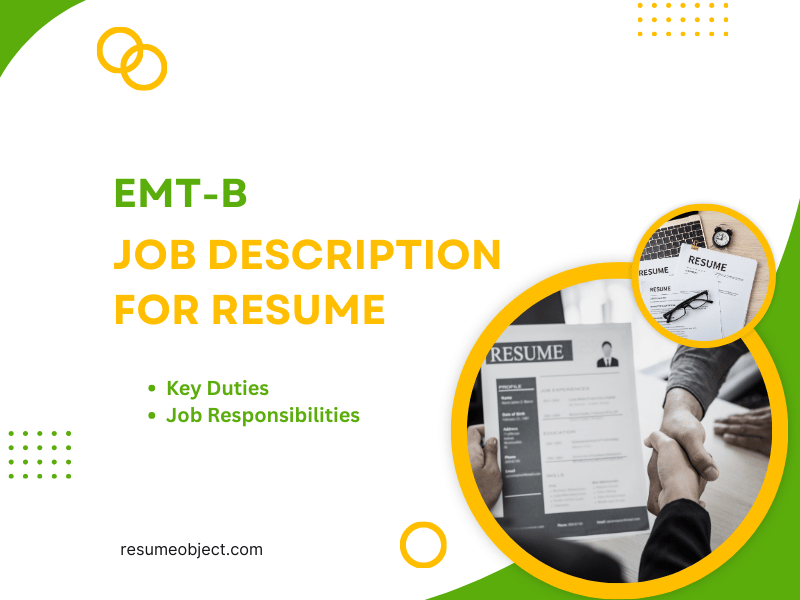
EMT-B Job Description for Resume
Discover the essential EMT-B job description for resume writing, including key duties, responsibilities, and impactful action verbs. Elevate your application and stand out to employers with our expert insights tailored for aspiring Emergency Medical Technicians.
Key Duties
Assess patient conditions and needs
Administer basic life support measures
Operate emergency medical equipment
Communicate with healthcare professionals
Document patient care and incidents
Required Skills
Patient Assessment
CPR and First Aid
Communication Skills
Emergency Response
Teamwork and Collaboration
Mistakes to Avoid in Job Description
Vague job responsibilities
Overly technical jargon
Lack of measurable achievements
Tips for Job Description
Use clear, concise language
Highlight relevant certifications
Emphasize teamwork and communication skills
Free Resume Templates





